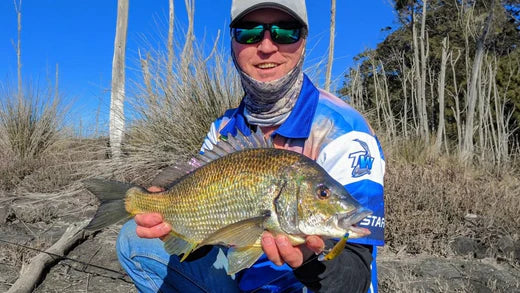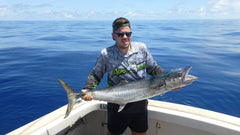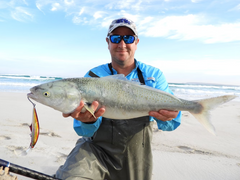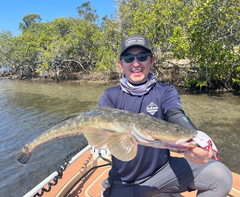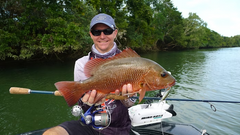Bream with Bait & Lures
by Nick Toozoff & Graham Herbert - Tackle World Moruya
Bream, scientifically known as Acanthopagrus, are a sought-after species in Southern NSW due to their abundance and often challenging nature. Achieving consistency when targeting bream is a significant milestone in an angler's life. They are anglers who can adapt to the changing moods of the fish, exploring different techniques and lures to find success. This blog explores the secrets to catching bream in Southern NSW using bait & lures.

What are Bream?
Bream inhabit estuarine habitats around Australia, favouring areas close to structure such as fallen trees and rocky outcrops. The maximum age of bream varies but can exceed 20 years.

Bream have distinct physical attributes such as a dark-coloured body with silver scales and a slightly downward sloping mouth. Yellowfin Bream have a silver to olive-green body with yellowish pectoral, ventral and anal fins. Yellowfin Bream have a deeper body and a higher snout than Black Bream who do not have yellow fins. Bream possess an impressive array of teeth for crushing shellfish, so fingers should be kept away from their mouths. Bream exhibit cautious behaviour and often require a stealthy approach to bait or lure presentations, especially where the water is shallow and clear. They can school in large numbers in the estuary during the cooler months of the year and competition for food can make them bold. Repeated casts to the same area where you caught fish can yield multiple hookups.

What is the Diet of Bream?
Bream feed on a variety of prey including prawns, crabs, small fish, and crustaceans and shellfish like oysters and pippies. Live worms and pink nippers pumped fresh are dynamic baits too. A good tip, if possible, is to fish near where you gather the live baits. If the bait species lives there, chances are the bream live there too!

How to Target Bream
Bream can be targeted from both shore and boat, with fishing close to structure yielding better results. Flicking lures or lightly weighted baits among fallen trees or other structures in upper estuaries is effective. They also respond well to berley. Learning to berley the water correctly to attract fish yet not overfeed them is an art and requires attention to detail that we will cover in another article soon.
Notable Conditions when Bream Fishing
- Bream can be found schooling in deeper channels, especially after significant or sustained periods of rain. They can tolerate a certain amount of fresh but prefer a good salty brew. The fish will gradually return to the upper reaches of the estuary system as water salinity improves with subsequent tides. Note, by fishing deep near the estuary floor, you can still encounter good fish.
- During October through November bream will be spawning. Exact times will vary due to climate factors and other variables. Soft plastics will effective during this time, as not all fish will be spawning at the same time. A well worked plastic will be just the ticket for some of the fish at this time.
- The summer period with rising water temperatures lead to increased activity among bream. If you have never caught bream on lures, now is the time to try. Once you have caught your first fish, the second ones come quite quickly. It is an extremely exciting time to on the water chasing bream.

Rigging Bait for Bream
- When fishing with bait, use as little weight as possible and rig the bait to drift naturally down the burley trail.
- When fishing from the beach my preferred rig is a 10’6” Sakana Coastline light rod rate 3-5kg and a 3000 sized reel spooled with 10-15lb braided line, rigged up with a running sinker rig on 12lb fluorocarbon leader and #4 long shank hook with beach worm, pippies or live nippers.
- When fishing over weedgrass areas in the estuary I like to rig lightly weighted or suspended baits of prawn, nippers and worms of bait keep style hooks.


-
In shallow clear water I use prawns and cut baits of mullet fillet rigged unweighted or lightly weighted rigged on small gang hooks for strip baits or a #1 Bait holder hook that is allowed to drift with the current and look as natural as is possible. Circle hooks also work well here, allowing the fish to swim away with your bait and hook themselves.
-
Float fishing also works well when combined with a berley trail. I use a quill or stem float and that is lightly weighted with split shot and a #4-2 Bait holder pattern hook that is set to sit about a foot off the bottom.

Size and Possession Limits for Bream
Size and possession limits for bream vary across different states of Australia. Anglers should consult local fishing regulations for specific information. For my area in NSW the bag limit is 10, with a possession limit of 20 and the minimum size is 25cm for both Yellowfin and black Bream. This was correct at time of publication but check the link below for any updates to the fishing regulations.
Best Gear for Bream Fishing
When fishing the estuary I like a light to medium outfit depending on the area I'm fishing. For the flats I like a longer, lighter rod like 7’6” 1-4kg Shimano Raider or Diawa TD Black 7’2” 1-3kg paired with a 1000-2500 size reel like the Diawa TD Black MQ or Shimano Vanford. There are plenty of excellent cheaper rod & reel options available that won’t break the bank as well.
The 7’6” rod allows me to cast light weights much further with less effort. Super important when trying to reach fish in the shallows without getting too close and alerting them to my presence. The extra length also provides me with a bit more shock absorption when using ultra-light lines and leaders. In windy conditions I find the long rod gives me more control over my casts and helps guide the braid when the wind has caught it. 7’6” does not mean heavy, and I find it a pleasure to use.

From the boat or kayak a shorter rod will make things easier and easier to troll with in the tighter reaches of the system. Here we like the rods in the 7’ 1-3kg or 2-4kg range with matching 1000 or 2500 sized reels.
Line & Leader: Braided or monofilament mainline in the 6-10 lb range with a 6-10lb fluorocarbon leader is suitable, with heavier leader recommended in snaggy areas.


My Best Lures for Bream
Bream respond well to slow-sinking lures like soft plastics, which mimic the natural movement of their prey. A variety of scented worm imitations and single-tailed grubs rigged on weighted jig-heads are effective. Practice patience, bream can be finicky, requiring a slow-sinking presentation that mimicks an injured prey item. Sometimes aggressive approaches will scare off the fish. Avoid working lures too quickly. We are big fans of the time tested and proven Daiwa Double Clutch hard body lures in 75mm size in either the deep or shallow running variations. There are also plenty of other hard body options available also.

When on foot walking the sandy shallow flats where the fish can be very spooky I use Jackson PY & EB Panic Prawn poppers and Zman, Rapala Crush City or Daiwa Bait Junky soft plastics on a light spin rods in the 7’ - 7’6” range as mentioned earlier.
Fishing from a boat or kayak gives you access to some areas like snags and rock bars that are impossible to reach from the bank, with the kayak getting you into tighter areas that a boat cannot. Here lure choice is much more varied and trolling from one spot to the next can also be employed. My best lures for boat fishing are any from the extensive range available from Daiwa, Atomic or Jackson.

One of the highlights in any bream session for me is seeing them take a surface presentation. Sometimes you can hear a loud sipping or kissing sound as the fish tries to suck the lure below the surface. At other times it’s a straight out aggressive smash and grab depending on the amount of competition for food. The best retrieve technique I’ve found on the local bream is pop pop pause retrieve. Bream can be spooky so they like to look at the presentation before committing to a strike.
When the going gets tough during times of dirty water, or I'm getting plenty of interest and follows but no bites, I'll add a bit of scent to the lure. I use either S-Factor from Shimano or Pro-Cure from Tackle Tactics. It really is a matter of personal preference as to what flavour or brand you use.
My Best Baits for Bream
Good baits for black bream include pink nippers, live and frozen prawns, pilchards, small strip/fillet baits, crabs from the rocks, pippies, worms, mullet fillet and baits like chicken breast, garlic bread and beef steak fat. Your choice of bait will also determine the size and pattern of hook you choose. My favourite pairings are Instinct bait holder hooks or Octopus Circle hooks, remember not to strike when using circle hooks, the fish will hook themselves when given time to swim away with your chosen bait.

Best Spots for Bream
When you're fishing the Eurobodalla Shire from just north of Batemans Bay down south to Wallaga Lake, you are in for some of the best bream fishing this state has to offer. Here are my 5 best spots to try your luck, whether you are bait or lure fishing.
-
Moruya River – the mouth to the upper fresh reaches.
For total access you can’t go past a boat, but there is plenty of action for the land-based angler too. You can fish the lower reaches by heading down past the Surf Club to Shelly Beach picnic area. From here you can walk quite a way around to the river proper. Another option is to fish near the Princess Highway bridge, or just down Ford Street from our shop to the boat ramp. The upper reaches can be accessed by driving to the end of Yarragee rd, and exploring from the carpark there. -
Coila and Tuross Lakes.
Just down the road are Coila and Tuross Lakes. These lakes can really turn the magic on with fish to 2kg having been caught here. These lakes are best fished from a boat, but if you are willing to put in the effort you can fish from the banks via Tuross Boulevard down past the golf course. -
Benegello Beach
Bengello Beach (aka Wind Sock) can be found by heading north along George Bass drive past the airport turn off. Look for the blue sign 1 runways length past the airport, the road is on right hand side.

Tackle World Moruya - Your Local Independent Fishing Experts
Welcome to the Eurobodalla's premium fishing tackle store - Tackle World Moruya. The team here are all passionate local fishers who strive to provide you with the best possible service and advice on where to fish, what products to use, and the techniques best suited to different species.

Corner of Ford & Queen Streets, Moruya, NSW 2537
Phone: (02) 4474 4381
So please come in and share a story and a laugh - you're always welcome here at Tackle World Moruya!
Services: Reel and rod repairs and servicing, line spooling and hot tips for the local area.
Or call NSW DPI on 1300 369 365

 Select Store
Select Store




